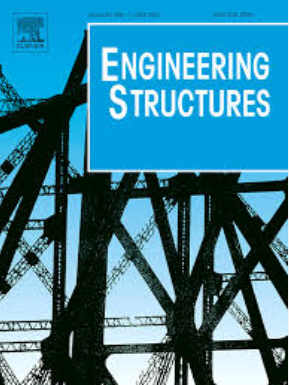Seismic performance assessment of bridges isolated by a new restorable cable-sliding bearing
IF 5.6
1区 工程技术
Q1 ENGINEERING, CIVIL
引用次数: 0
Abstract
Although a large number of girder bridges use frictional flat sliding bearings to support bridge superstructures, these bearings may have excessive seismic displacement caused by strong earthquake due to the absence of the restorable ability. To improve the restorable ability, this paper presented a novel seismic isolation bearing based on flat sliding bearing and restorable cable restrainers, called Restorable Cable-sliding Bearing (RCB). The restorable cable restrainers in RCB are made up of steel cables and springs, which are used to limit large displacement and provide restorable forces for flat sliding bearings. In this paper, quasi-static tests were first conducted to study the seismic behavior of RCB, which was also used to calibrate analytical and numerical simulation methods. The effectiveness of RCB was then illustrated by a typical two-span reinforced concrete bridge. By comparing with flat sliding bearings, both nonlinear time-history analysis and fragility analysis were performed to study seismic performance of RCBs. Finally, a new factor based on the fragility difference between different components was also proposed to demonstrate the effectiveness of RCB on bridge system. It can be found that the proposed RCB can improve the restorable ability of flat sliding bearings, which can limit the excessive displacement and produce relatively small residual displacement under strong earthquakes.
求助全文
约1分钟内获得全文
求助全文
来源期刊

Engineering Structures
工程技术-工程:土木
CiteScore
10.20
自引率
14.50%
发文量
1385
审稿时长
67 days
期刊介绍:
Engineering Structures provides a forum for a broad blend of scientific and technical papers to reflect the evolving needs of the structural engineering and structural mechanics communities. Particularly welcome are contributions dealing with applications of structural engineering and mechanics principles in all areas of technology. The journal aspires to a broad and integrated coverage of the effects of dynamic loadings and of the modelling techniques whereby the structural response to these loadings may be computed.
The scope of Engineering Structures encompasses, but is not restricted to, the following areas: infrastructure engineering; earthquake engineering; structure-fluid-soil interaction; wind engineering; fire engineering; blast engineering; structural reliability/stability; life assessment/integrity; structural health monitoring; multi-hazard engineering; structural dynamics; optimization; expert systems; experimental modelling; performance-based design; multiscale analysis; value engineering.
Topics of interest include: tall buildings; innovative structures; environmentally responsive structures; bridges; stadiums; commercial and public buildings; transmission towers; television and telecommunication masts; foldable structures; cooling towers; plates and shells; suspension structures; protective structures; smart structures; nuclear reactors; dams; pressure vessels; pipelines; tunnels.
Engineering Structures also publishes review articles, short communications and discussions, book reviews, and a diary on international events related to any aspect of structural engineering.
 求助内容:
求助内容: 应助结果提醒方式:
应助结果提醒方式:


